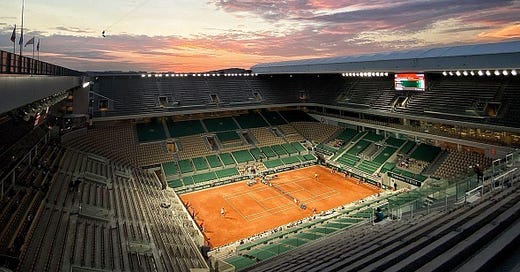Centre court at Roland Garros.
It’s the French Open tennis competition at the moment, and most of the conversation one hears in the cafes is about just that.
I grew up with tennis. Not only Wimbledon and the Davis Cup but locals playing on the courts scattered across the country town where I was raised. All red clay or asphalt, of course. I didn’t see a grass court until I moved to England.
Back then, Australians like Lew Hoad and Rod Laver were the gods of tennis, sweeping every prize. Watching friends glued to their radios, riveted by the bock…bock…bock…roar of the broadcast from the other side of the world, I wished I could share their enthusiasm; even enjoy tennis. Unfortunately, that gene was omitted from my genome.
Colour television made tennis a glamour sport. The red clay of the Stade Roland-Garros is as instantly recognizable as the green of Wimbledon or the blue court surfaces of Australia and the United States. Actually, it isn’t ‘clay’ at all but brick dust, only a few centimetres deep, spread over a bed of limestone. Trust the French, by choosing a surface that retains a sense of the tropics, to once again favour poetry over the practical. There’s drama in the red earth of the south. If Wimbledon’s lawns are redolent of cucumber sandwiches and strawberries and cream, the clay of Roland-Garros brings a whiff of Provençal heat and the scent of wild thyme. Wimbledon is David Hockney; Roland-Garros Picasso.
Poster for the French Open 2020 by Pierre Senturier
Visitors assume that Roland Garros, to have had the complex named for him, must have excelled in sports. In fact he was an aviator, the first man to fly across the Mediterranean, and inventor of a machine gun which, firing through the blades of a propellor, transformed aerial warfare. Paradoxically, he fell victim to his own invention, shot down during the last days of the First World War.
Small, dark, with a dashing moustache, Garros cycled, played football, rugby and tennis, and raced the cars of his friend Ettore Bugatti. He was also an accomplished pianist, and a familiar figure at the fashionable salons of Paris.
At one of these he met American dancer Isadora Duncan, who performed to his playing of Chopin and invited him to escort her back to her hotel. They paused in the Place de la Concorde as the alert sounded for an air raid, and she danced for him alone in the empty square as anti-aircraft batteries roared and searchlights probed the sky overhead. ‘He applauded me,’ she wrote, ‘sitting on the edge of a fountain, his melancholy black eyes shining with the fire of the rockets which fell and exploded not far from us. Shortly after, the Angel of Heroes seized him and carried him away.’
Roland Garros in 1910.
The poet and artist Jean Cocteau loved Garros, though it’s not clear whether they were lovers. Garros did take him for night flights over Paris, an experience that inspired Cocteau to poetry. ‘He flies as he breathes,’ he wrote. Garros was also mourned by Émile Lesieur, a school friend and fellow pilot who became an important figure in French sports. It was Lesieur who spontaneously decreed that the new tennis centre, constructed in 1928 to defend what was, at the time, France’s overwhelming superiority in the sport, should bear his friend’s name.







I’m horrified that the young French kids under thirty give, who claim to be big tennis fans don’t know a single name of a player before Monfils! To think their country was so pivotal in the sport. They say, ohh we never win a gs finals and I repky— in the 90s , there were more than six French players in the top twenty. They don’t know any of those names— Simone, gasquet— let Aline the musketeers. I wonder if they know if Lacoste. I find it quite amusing . Hello from a writer and ex jr pro newly moved here from ny via Calcutta.
You know the summer is on its way when the French Open and Wimbledon appear on the horizon. I was no good at tennis but adored the brat John McEnroe tennis 🎾